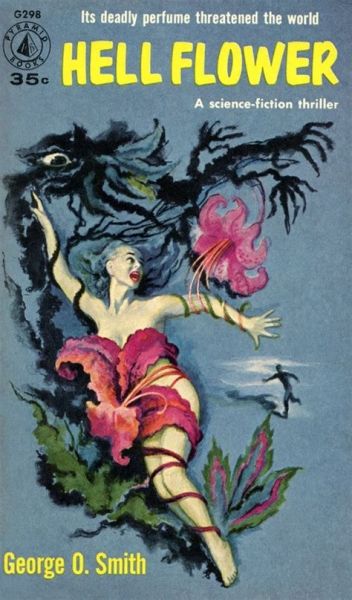No Escape That I Can See
Hellflower
By George O. Smith

23 Apr, 2023
George O. Smith’s 1953 Hellflower is a stand-alone tale of interplanetary intrigue.
Charles Farradyne was scapegoated for the wreck of the Semiramide on Venus. Although he was not found guilty, the public believes him guilty of negligence and Farradyne was stripped of his pilot license. Four years after the Semiramide sank into the Bog, Farradyne is a bitter, desperate man making a meagre living on Venusian fungus farm.
Howard Clevis of the Solar Anti-Narcotics Department [SAND] dangles reinstatement in front of Farradyne. There is, of course, a catch.
Hellflowers are the primary scourge of modern life. They look like gardenias, but act like roofies. One sniff will turn any woman into the slave of the nearest man. If that were not alarming enough, one side-effect is to dull almost all emotions save the most negative. SAND is determined to suppress the Hellflower trade. The only problem is, they don’t know where Hellflowers are grown.
Farradyne is provided with a space ship and ample funding. He is also given pilot papers convincing enough to pass casual inspection, but not detailed investigation. Farradyne’s task is to travel the space lanes from Mercury to Pluto, looking shady.
SAND hopes the fish that snaps at the bait will be Hellflower smugglers. Thanks to a chance encounter, the fish that snaps at the bait is Hellflower victim Norma Hannon, whose brother Frank died on the Semiramide. Norma can no longer feel most emotions but she can feel hate for her brother’s killer. Determined to keep a spark of emotion alive, Norma stalks Farradyne with considerable success.
With great effort, Farradyne fobs the pesky moll off on her relatives (temporarily). Returning to his task, he enjoys enormous success, at least as far as catching the attention of Hellflower smugglers posing as the respectable middle-class Niles family, a family whose members include alluring space sweetie Carolyn. This could be the in that the pilot and SAND need to unravel the Hellflower trade.
It is a trap. Neither Farradyne nor SAND understand the nature of the enemy. Farradyne is targeted for death by an interstellar conspiracy!
~oOo~
I was inspired to reread this purely because it happens to have the same title as the eluki bes shahar novel reviewed here. Bad idea. This novel turned out to be a stinker that was deservedly forgotten.
It seems to me that if space roofies are a pervasive, society-endangering challenge, that says damning things about the men of the future. Nothing in the book contradicts that. Not only are a surprisingly high percentage of men willing to offer their dates Hellflowers1, nobody appears to think this is sufficiently alarming to stop including gardenias, which look just like Hellflowers, in bouquets and corsages. For that matter, people are still accepting bouquets and corsages that have gardenias in them, each time risking exposure to Hellflowers.
Women appear to be both coveted and feared. Top men agree that Hellflowers are bad for society. They feel sorry for the victims. At the same time, Farradyne’s main source of exercise seems to be dame-slapping and nobody seems to find issue with Mr. Niles’ proposition that “women are poison.” All of which makes the sudden romance plot at the end unexpected, although the manner in which Farradyne decides he loves Norma (for no obvious reason), then pivots to Carolyn when Norma turns out to have had her own (entirely off-stage) romance … well, that seems in character.
I did like the fact that minor characters had their own lives even when not in view of Farradyne but otherwise, this novel was a chore to read. It is fortunate the book is short or I might have failed to finish it. I thought I was a George O. Smith fan, but given my reaction to this book and to Path of Unreason, I wonder if I’m actually just a fan of Smith’s Venus Equilateral.
On thinking this book over later, I realized that the setting (interstellar drug trade) is suspiciously reminiscent of the Lensmen series. There are some notable differences, most particularly that Lensmen was a thrilling space opera filled with blackest black and whitest white, whereas Hellflower is a space noir where everything is shades of gray. Farradyne isn’t a nice man and the interstellar enemy aren’t epic villains, just war-shy people2 determined to be the local top dogs.
Hellflower is available on Project Gutenberg. Don’t say I didn’t warn you!
1: Farradyne is willing to use a Hellflower, but only as a means of getting information from Hellflower smuggler Carolyn. Honest! What he learns is that she’s immune to Hellflowers.
2: Carolyn’s people are human, albeit ones with odd voice boxes that let them speak in three tones simultaneously. Farradyne remembers Carolyn asserting that Solarians and the enemy come “from the same basic stock some fifty thousand years ago.” Frustratingly, I cannot find the passage where Caroline actually said that. Vestige of a previous version of the novel?
